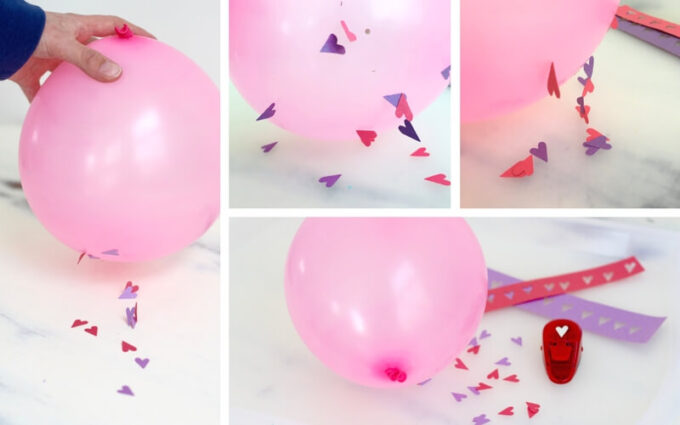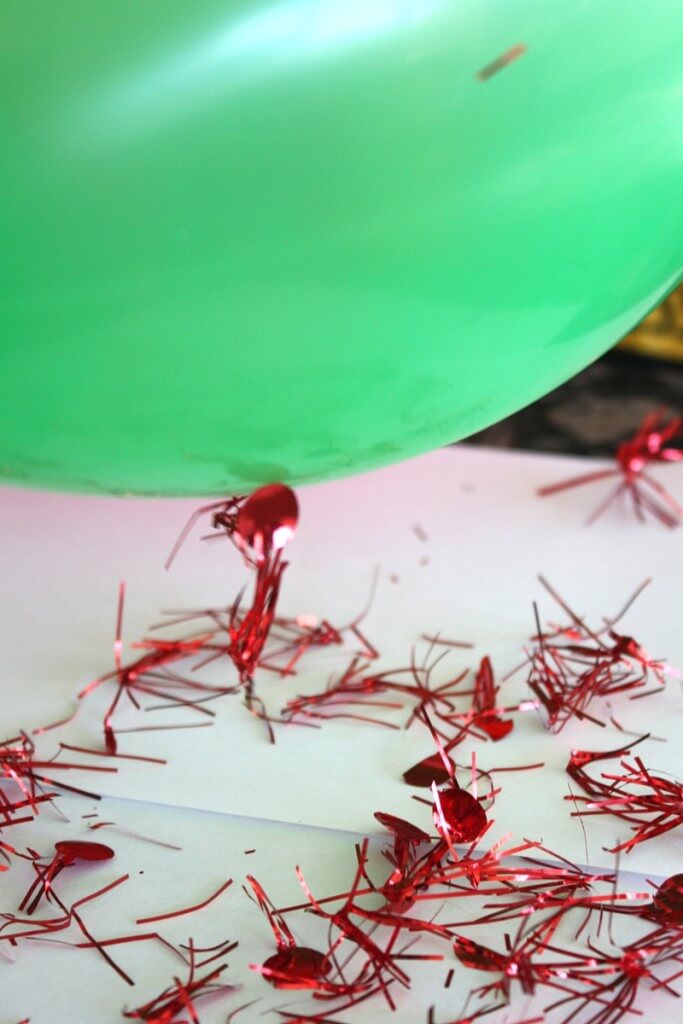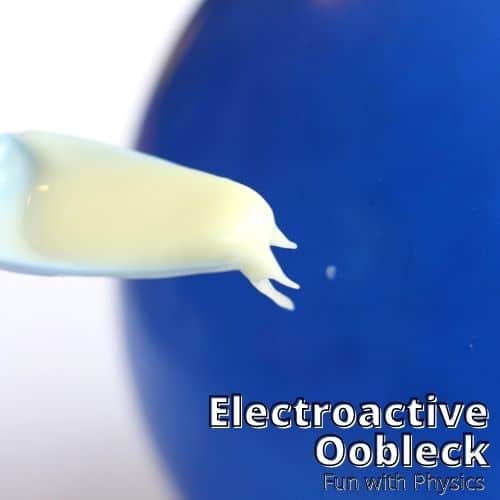Ever noticed how when you rub a balloon against your hair, it sticks to the wall? That’s static electricity in action! Learn more about this fun science concept with simple static electricity experiments, and everyday examples of static electricity. Enjoy hands-on physics experiments for kids!

Explore Static Electricity For Physics
Static electricity happens when tiny particles called electrons build up on an object, making it either positively or negatively charged.
When these charged objects get near each other, they can do some pretty cool things, like making your hair stand on end or attracting small things, like pieces of paper or confetti.
So, static electricity is all about the invisible forces that make objects stick together or repel each other, and it’s a fun and fascinating part of science that you can explore with simple static electricity experiments below.
For more ways to explore physics with kids, check out our list of easy physics experiments.
What Is Static Electricity?
Think of tiny invisible particles called electrons as little magnets. Everything around us, like your hair, a balloon, or even a piece of cloth, is made up of these particles. Learn more about electrons here.
Sometimes, when two things rub against each other, like when you rub a balloon against your hair, the electrons can get all jumbled up and move from one thing to the other.
When this happens, one thing gets extra electrons, and the other thing loses some. The one with extra electrons becomes negatively charged, like a minus sign, and the one that lost some becomes positively charged, like a plus sign.
These opposite charges make things stick together or repel each other, like magnets with opposite ends.
So, when you rub the balloon on your hair, it’s taking some of your hair’s electrons, making the balloon negatively charged.
That’s why the balloon can stick to the wall or make your hair stand up—all because of those jumbled-up electrons creating static electricity. It’s like a tiny invisible magic show happening all around us!
Get your FREE printable science worksheets!
Examples of Static Electricity
Here are some everyday examples of static electricity that you can explain to kids. These examples help kids understand that static electricity is all around us, and it can be both fun and surprising when we see it in action. It’s like a little bit of science magic happening every day!
- Balloon on the Wall: When you rub a balloon against your hair and then stick it to the wall, it’s static electricity at work. The balloon becomes negatively charged from the friction, and it sticks to the wall, which has a different charge.
- Walking on Carpet: Sometimes, when you walk on a carpet with socks, you may feel a shock when you touch a metal doorknob. This happens because you build up a charge by rubbing against the carpet, and when you touch the doorknob, the charge flows and gives you a little shock.
- Socks and Jumping Beans: Sometimes, when you take off your socks after walking on a carpet, they might attract small items like jumping beans or bits of paper. The socks get charged as you walk, making them attract other small objects.
- Static Cling in the Dryer: When you take clothes out of the dryer, they might sometimes stick together or to the sides of the drum. This happens because of static electricity from the friction of the clothes rubbing against each other.
- Balloons Stick Together: If you rub two balloons against your hair and then bring them close together, they might stick to each other. This is because the like charges (both negatively charged) on the balloons repel each other.
- Crackling Sounds in the Winter: In cold, dry weather, you might hear crackling sounds when you touch things or take off your winter hat. That’s static electricity being discharged.
- Lightning: Explain how lightning during a thunderstorm is a massive example of static electricity in nature. It happens when negative charges build up in the clouds and discharge as a bright bolt of lightning to the ground.
- Petting a Cat or Dog: Sometimes, when you pet your cat or dog, you might feel a little shock when you touch their fur. It’s because of static electricity from friction between their fur and your hand.
Static Electricity Experiments For Kids
Here are some simple and fun examples of static electricity experiments and demonstrations that are great for learning at home or in the classroom.
Static Electricity with Balloons
Rub a balloon against your hair or a piece of wool cloth, and then place it near small pieces of paper. The paper should be attracted to the balloon, demonstrating the effect of static electricity. What happens when you use different types of cloth?

We’ve tested lightweight paper, tissue paper, and tinsel! What else can you test?

Static Electricity with a Plastic Straw
Rub a plastic straw with a piece of cloth or fur and then use it to pick up small pieces of paper or confetti. The static charge on the straw will make the paper pieces stick to it.
Static Electricity with a Plastic Bag
Inflate a plastic bag and rub it against your hair or a piece of fabric. Hold the bag near a wall, which should stick to the wall due to the static charge.
Static Electricity with a Balloon and Salt and Pepper
Rub a balloon against your hair and then bring it to a plate of salt and pepper. The salt and pepper will be attracted to the balloon, demonstrating the power of static electricity.
Static Electricity with a Comb and Water
Run a comb through your hair and bring it near a thin stream of water. The water will be attracted to the comb and bend towards it.
Check out the experiment details further below!
Static Electricity with Cornstarch Goop
Make electric goop! Mix up a batch of cornstarch oobleck and test out the power of static electricity with a balloon.
Try This Static Electricity Experiment with a Comb
This comb and water static electricity experiment is a fun way to demonstrate the principles of static electricity to kids.
Supplies:
- A plastic comb (the type with fine teeth works well)
- A running faucet or a source of water
- A small piece of dry paper or a small piece of tissue
- A piece of dry cloth or wool (a piece of wool fabric or a wool sweater works great)
Instructions:
STEP 1. Take the dry comb and rub it vigorously against the dry cloth or wool for about 20-30 seconds. This rubbing creates a buildup of static electricity on the comb.
TIP: If the comb is not dry, be sure to dry it with a paper towel or cloth so that it’s completely free of water.
STEP 2. Have a running faucet nearby or fill a small sink with a shallow layer of water.
STEP 3. Now, while still holding the comb, bring it near the running faucet or the water surface without actually touching the water.
You should see that the water stream bends toward the comb, as if the comb is magically attracting the water.
TIP: You can also try this with a small piece of tissue instead of running water. When you bring the charged comb close to the tissue, you’ll notice that it’s attracted to the comb.
What is happening?
When you rub the comb against the cloth or wool, it picks up extra electrons and becomes negatively charged. The water or tissue has a positive charge.
Opposite charges attract, so the negatively charged comb attracts the positively charged water or tissue. This is a simple demonstration of the principles of static electricity.
Make sure to explain this concept to the kids while conducting the experiment, and encourage them to try it themselves. It’s a great way to make science fun and interactive for children.
Helpful Science Resources To Use
Here are a few resources that will help you introduce science more effectively to your kiddos or students and feel confident yourself when presenting materials. You’ll find helpful free printables throughout.
- Best Science Practices (as it relates to the scientific method)
- Science Vocabulary
- 8 Science Books for Kids
- All About Scientists
- Science Supplies List
- Science Tools for Kids
- Join us in the Club
Science Experiments By Age Group
We’ve put together a few separate resources for different age groups, but remember that many experiments will cross over and can be re-tried at several different age levels. Younger kiddos can enjoy the simplicity and hands-on fun. At the same time, you can talk back and forth about what is happening.
As children get older, they can bring more complexity to the experiments, including using the scientific method, developing hypotheses, exploring variables, creating different tests, and writing conclusions from analyzing data.
- Science for Toddlers
- Science for Preschoolers
- Science for Kindergarten
- Science for Early Elementary Grades
- Science For 1st Grade
- Science for 3rd Grade
- Science for Middle School
Printable Science Projects For Kids
If you’re looking to grab all of our printable science projects in one convenient place plus exclusive worksheets and bonuses like a STEAM Project pack, our Science Project Pack is what you need! Over 300+ Pages!
- 90+ classic science activities with journal pages, supply lists, set up and process, and science information. NEW! Activity-specific observation pages!
- Best science practices posters and our original science method process folders for extra alternatives!
- Be a Collector activities pack introduces kids to the world of making collections through the eyes of a scientist. What will they collect first?
- Know the Words Science vocabulary pack includes flashcards, crosswords, and word searches that illuminate keywords in the experiments!
- My science journal writing prompts explore what it means to be a scientist!!
- Bonus STEAM Project Pack: Art meets science with doable projects!
- Bonus Quick Grab Packs for Biology, Earth Science, Chemistry, and Physics










